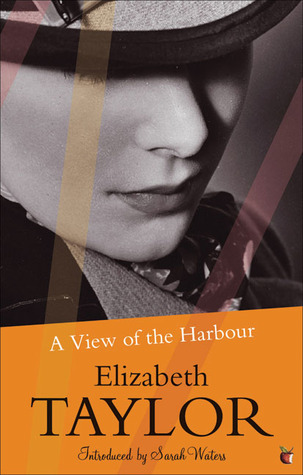Yet Elizabeth Taylor, the writer, published twelve novels and several collections of short stories from 1945 right into the 1970s and, although since neglected, is today finding recognition as one of the under-valued novelists of the twentieth century. I first became aware of her when her name began to crop up regularly in some of the book blogs I follow and settled on reading her third novel A View of the Harbour.
The story opens with Bertram, an out-of-season visitor to the coastal village of Newby, who thereby casts a fresh perspective on its jaded post-war harbour and inhabitants. Ostensibly, he's there to paint the views but takes much greater delight in insinuating himself into the everyday lives of residents like elegant divorcee Tory Foyle and infirm busybody Mrs Bracey. The viewpoint shifts to other protagonists, as we begin to discover the burgeoning relationship between Tory and Robert, the doctor who lives next door and happens to be the husband of Tory's best and oldest school-friend Beth. A writer immersed in her stories, Beth primarily views real life experiences as material for her books, which leaves her ignorant of what's going on under her nose, unlike her more observant daughter.
Superficially, there may not be all that much happening in this novel, but there's a great deal milling about just beneath the surface, in the little looks and sideways glances, the dynamics of relationships between families and so-called friends. At the beginning, so many characters are introduced in such a short space of time that I found myself confused, particularly as they're all too often peering out of an upstairs window onto the harbour below or going to, or thinking about going to, the pub.
Gradually, the characters take on more rounded, well-defined shapes and, as Taylor inks them in with a wryly expert hand, many develop an inner dialogue at odds to their actions. Mrs Bracey may appear a coarse and demanding invalid with little sympathy for the drudgery she's inflicting on her daughters, but turns out, in struggling with her own mortality, to be a surprisingly complex and intelligent interpreter of the motives of others. And there's a feeling that Taylor is having fun with some of her minor characters, such as Tory's son Teddy and his delightful notes home from boarding school, or the never-named librarian
an old man with an ink-pad and a large oval stamp, with which he conducted a passionate, erratic campaign against slack morals. His censorship was quite personal. Some books he could not read and they remained on the shelves in original bindings and without the necessary stigma 'For Adults Only'. Roderick Random stood thus neglected, and Tristram Shandy, vaguely supposed to be children's books. Jane Eyre, bound and rebound, full of loose leaves, black with grease, fish-smelling, was stamped back and front. Madame Bovary had fallen to pieces.I loved the readers '...bewildered, misled...' searching for the pornography in Jane Eyre and the librarian's fixed standards where
Murder he allowed but not fornication. Childbirth (especially if the character died of it) but not pregnancy. Love might be supposed to be consummated as long as no one had any pleasure out of it.Interwoven with Taylor's humour there's a pervading theme of loneliness in this book. Losses sustained in the Second World War are still raw; widowed Lily Wilson now lives with only a ghoulish collection of waxworks of serial killers for company, a seasonal attraction which she opens to visitors in the summer but has to endure every evening as she returns from her lonely bar-side vigil. She of all residents is most flattered by Bertram's attention and let down by his butterfly ways.
Although we never find out the location of Newby (but it's close enough to London for day trips) there's a great sense of place in this novel and of a livelihood slipping away, eclipsed by the new town just around the headland.
As first, I didn't think I was going to enjoy the claustrophobic, small-town atmosphere of this book, with its considerable cast of characters watching and being watched, gossiping and making do. But as I got to grips with their individual personalities, I started to empathise with their dilemmas and revel in the fine writing. Elizabeth Taylor creates nuanced, often humorous, characters but is not afraid to strip them bare and expose their souls. On the basis of A View of the Harbour, she deserves her renewed recognition.
Elizabeth Taylor's A View of the Harbour with an introduction by Sarah Waters is published by Virago Press and is currently available from The Book People for £4.99 as part of a three book set.

.jpg/220px-Elizabeth_Taylor_(novelist).jpg)
No comments:
Post a Comment
I'd love to hear what you think! Please let me know in the box below